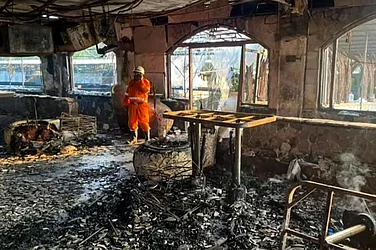Coastal regions of the world are eco-fragile systems as they integrate complex processes like tidal systems, offshore currents, waves, erosion, accretion, beaches, dunes, wetlands, tidal channels. Due to the global impact of climate change, the United Nations Framework Convention on Climate Change (UNFCC) is strongly leading nations to initiate action plans for sustainable development. In Asia, sea level rise is considered as one of the severe threats. Goa has 105 km of seafront along the Konkan coast, southwest of India. The lowest land in Goa is uniquely known as the khazan ecosystem. These are land livelihood systems traditionally evolved by local communities through experiential learnings over thousands of years. The land, which was once low-lying tidal flood plains, was engineered intricately with dykes, sluice gates and water channels. Traditional occupations supported were agriculture, aquaculture and salt making. The indigenous village communities, also known as Gaunkari (common pool resource) villagers or co-owners, maintained these khazan infrastructures for their annual food produce. Socially, economically and environmentally woven into their lifestyle, these khazans are the cultural landscape of Goa’s villages. Today, these existing ecosystems additionally have inherent potential to withstand sea-level rise or flooding and other related coastal risks from climate change. Currently, events such as tides whose range extends up to 2.5 m, and heavy daily rainfall of 0.3 m occur simultaneously, with progressively increasing sea level, the total rise in water levels easily reach three metres. Khazan ecosystems and their potential to defend against coastal hazards can provide a base map to authorities for disaster management in Goa.
What is the scope of this study?
In view of climate change risk of sea level rise what is the defence capability of khazan ecosystems, the extent of khazans impacted in Goa’s most vulnerable taluka? What are the governing systems which need attention locally? Finally, what are the resilience measures that need urgent consideration? All of this involves understanding an age old vernacular system. Its design, evolution and management needs to be highlighted. The spatial analysis can establish the topography modelling to identify the risk areas. The ground truthing data can corroborate the physical state for prioritising action plans.
ALSO READ: Tears Of The Mermaid: The Melancholy Of Goa
Can khazans defend Goa?
As per the research available on khazans by eminent local researchers, it is amply clear the ecosystems had specific components which were typically present in all khazan locations. Since reclaiming low-lying land involves draining it for productive use, the existing khazan infrastructure was built to protect land from saline water ingress and to regulate it while draining. So, dykes (locally called bunds), sluice gates (locally called manos) and water bodies networks (locally called poiems) were establish in each extent of khazans that lie along rivers or their tributaries. These systems are worthy of GIAHS (Globally Important Agricultural Heritage Systems) status. The digital elevation of these areas reveal that most of them are within a 5 m elevation. The estimated extent of khazans across Goa is 18,500 hectares (185 sq.km). Half of this is within Tiswadi, the smallest taluka of north Goa. The coastal talukas of Tiswadi, Bardez and Salcete comprise of the majority of the khazan land along the Goa coast. This corroborates the fact that these three talukas are listed as most vulnerable and has the most bunds across its territories built to protect its land. The bund records available in the notifications of the Government of Goa shows approximately 500 bunds across Goa, 300 of which are within these three vulnerable talukas. Traditional knowledge and vernacular methods have been adopted by the ancestral communities to build these systems inch by inch through extensive manual labour and experiential learning. The communities sustained themselves in an integrated manner with nature and both thrived. If we consider the technology, scale of work, management practices, etc, these ecosystems seem to be ancient handmade marvels. The land within these khazan extents is all low lying and therefore needs to be protected from inundation by the bunds, which are along the outer water bodies. Principally therefore, these are defence systems required to protect land from inundation. Local communities completely agree with the reality of climate change risk of sea level rise and the fact that water levels have risen over the years. They also know that the existing khazan infrastructure is all they need for managing a flood disaster. The khazans were mainly designed as defence for livelihood through land management and thus have inbuilt capability to defend a sea-level rise.
What are the resilient choices?
The site observation of each component of a khazan ecosystem reveals that they were built with sustainable materials like silt/clay, hay, wood, bamboo, etc. The management systems built around these were for 24-hour surveillance and upkeep. As these were community ‘common pool resources’, the maintenance of these systems affected the livelihood of all and were hence considered high priority. However, their deteriorating condition point to various factors like management failure, changes in administrative and ownership status, land use and demography; enactment of new land laws, unavailability of skilled local workers and indifference of village communities. The advent of cement has also forced its unsustainable use in many khazans, which not only have structural issues in water-based areas but also cause pollution, biodiversity damage and aesthetic stress on the cultural landscape. It will be a slap on the face of our ancestors if tomorrow, we replace all the 500 bunds in Goa with concrete, to claim that we are defending ourselves from sea level rise, while killing the very reason–sustainability—they survived so many years. The hard toil and sweat of their hands will be turned into waste.
Can khazans be the green corridors?
Goa has tourism potential in all its landscape. Khazan ecosystems are no different. Sustainable practices clubbed with traditional knowledge are the way forward. Why would anyone be interested to see an age old system converted to concrete? Instead, if these systems make value additions by converting into green corridors across Goa, it would be a marvelous feat whose showcase could draw tourists. There is enough green knowledge expertise and technology to support and convert these spaces to not only sustain the occupational potential for the locals, but also add a tourism potential for their sustenance. Why wouldn’t a visitor be interested in seeing how Goa’s ancestors planned their lives and livelihoods, and more so, how the present communities have transitioned it with a whole new approach. In a decade of achieving sustainable development goals globally, we need to cross the comfort zones of our ivory tower planning and get on to the ground to feel how nature engineers its systems sustainably. Khazans are uniquely capable as flood defense and can be the green corridors of Goa.
(This appeared in the print edition as "The Green Corridors")
ALSO READ
Elsa Fernandes is a Goa-based environmental architect





















